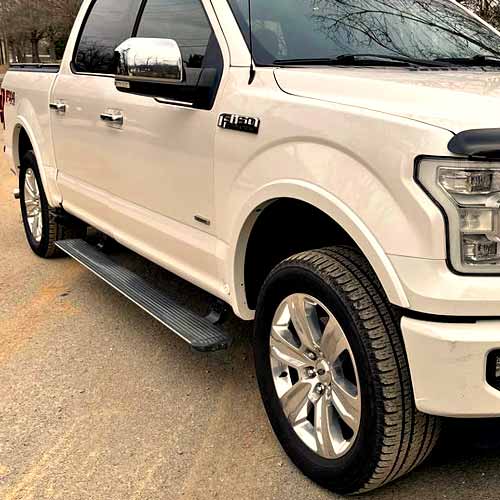All-terrain tires are although available in a wide variety of sizes, that start from 15 inches to 20 inches in diameter, the most common all-terrain tire size is 265/70R17. Let’s see what these numbers tell you.

But first here’s the list of the most common all-terrain tire sizes, listed from most to least common:
- 265/70R17
- 235/65R17
- 225/75R16
- 255/70R16
- 265/75R16
- 285/75R16
- 245/75R17
- 235/85R16
- 225/85R16
Table of Contents
What these numbers denote?
On 265/70R17, the 265 is the number telling width of the tire in millimeters. 70 is the aspect ratio, meaning its the ratio of the tire’s sidewall height to its width. R stands for “radial construction” and the number 17 in the end is the diameter of the wheel (in inches).
I’ve discussed each of them below in details.
But first, make sure you check out: https://tiredriver.com/all-terrain-tires/
Width
Wider tires (generally) get to have better traction and grip, as they offer more rubber to road meet up. However, they also tend to be heavier and may cause more rolling resistance, which can negatively impact fuel efficiency and acceleration.
Moreover, wider tires do good on rocks, with their ample footprint, whereas on snowy terrains, you are better off with a narrower section width.
These are some of the important factors to consider when it comes to all-terrain tires, so choosing a tire with balanced section width is important.
Aspect Ratio
Like mentioned above the aspect ratio tells you about the thickness of the sidewalls. So in the tire size, 265/70/R17, the aspect ratio of 70 tells you that the sidewalls would be 70% of 265 = 185.5mm thick.
Sizes with lower aspect ratio (such as 30 or 35), indicated shorter sidewall (consider low profile tires here). And these although improves handling and stability at high speeds, they compromise a lot on overall ride comfort.
Though you can’t just make sidewalls too tall either, as besides impacting handling and stability, they also can interfere with your suspension components.
See Further In: How To Read Tire Sizes?
R – Radial
Some folks think R stands for “rim” or even worse “radius”, whereas it simply tells you about the internal construction of the tire, that its radial.
This type of construction consists of layers of polyester, fabric and steel plies arranged at 90-degree angles to the center-line of the tire.
Don’t confuse yourself with it, as its simply a most common construction, and is mostly talked about in contrast with bias-ply internal builds (which was the old way tire’s were constructed internally).
Rim Size
The 17 at the end of 265/70R17, tells you about the diameter of the wheel the tire is eligible for.
Stating the obvious, the diameter of the rim must match the diameter of the tire. If the rim is too small, the tire will not fit properly and may come off the rim while driving, even if you somehow manage to pull it off.
For Your Info: Keep in mind, the offset of the rim matters a lot. It’s the distance of the rim’s mounting surface to the center-line of the wheel. A positive offset means the mounting surface is closer to the outside of the wheel, while a negative value tells you that it’s closer to the inside. If not aligned these can push the tire out sideways during turns, compromising on a lot of performance areas, like wear, handling and so on.
Why is 265/70R17 the most common all-terrain tire size?
Now considering the above discussion, I can easily explain why this size gets to be the most common one.
265/70R17 is basically a versatile size that gets to suit a lot of vehicles, particularly light trucks and SUVs. It supplies you with a good balance of ride comfort, handling, and off-road capabilities. Moreover, it fits well on most common wheel sizes and rim widths, making it a popular choice for many vehicle manufacturers.
The 265 section width is a nice balance when it comes to all-terrain tires, it ensures maximum stability without compromising too much on fuel economy and tread wear.
Moreover as the section width is really important for snow, with this much tread width, sizes get to have 3 Peak Mountain Snowflakes ratings along with M+S).
(Skinnier tires basically do great when it comes to winter performance, that’s why some tires, like the Baja Boss A/T isn’t able to offer this winter rating on tread width exceeding 12.5 inches, the 265 mm only comes out to be 10.4 inches).
Lastly the aspect ratio of 70 offers a good enough comfort and steering response balance, while allowing you to have off-road traction with lowered air pressure (with sidewall lugs).
With this ratio, (70% of 265), the tire has ample sidewalls to get traction with lowered air pressure, and at the same time, it’s not to much to causes any serious stability or handling issues as well.
Common Sizes according to vehicles
A/T tires come in a lot of variations, yet in terms of vehicle types, following are most common all-terrain tire size:
- Light trucks and SUVs: 265/70R17, 255/70R16, and 245/75R17.
- Pickups: 265/70R17, 255/70R16, and 285/75R16.
- Vans: 235/65R17, 255/70R16, and 245/75R17.
- Small SUVs and Crossover vehicles: 235/65R17, 225/75R16, and 245/75R17.
Conclusion
265/70R17 is the most common all terrain tire size. Though keep in mind that there are a lot of factors contributing to that.
And in order to explain them all, I’ve talked about section width, aspect ratios, and rim sizes and how they affect the overall performance.